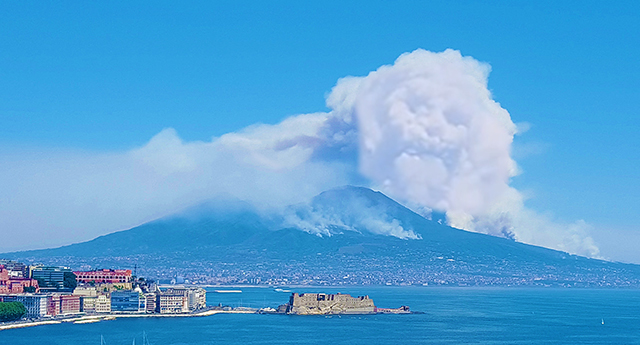Archaeologists find records of Pompeii’s survivors, proving many survived Mount Vesuvius eruption
06/12/2024 / By Kevin Hughes

Archaeologists have found records indicating that many people from Pompeii survived the cataclysmic eruption of Mount Vesuvius.
On August 24 in 79 A.D., Mount Vesuvius erupted after centuries of dormancy, devastating the once prosperous Roman cities of Pompeii and Herculaneum and killing thousands. Based on most modern accounts, both cities were destroyed with their people fossilized. (Related: Vesuvius eruption wiped out people of Pompeii because it lasted longer than 15 minutes, study finds)
The latest research is threatening to upend the narrative about the story of the eruption of Mount Vesuvius from one of total destruction to one that also discusses what happened to the people who survived the eruption and were able to rebuild their lives.
This is thanks to historian Steven L. Tuck of Miami University whose search for survivors and their stories has dominated the past decade of his archaeological fieldwork as he tried to find out who might have escaped the eruption of Mount Vesuvius.
“Pompeii and Herculaneum were two wealthy cities on the coast of Italy just south of Naples. Pompeii was a community of about 30,000 people that hosted thriving industry and active political and financial networks,” Tuck said. “Herculaneum, with a population of about 5,000, had an active fishing fleet and a number of marble workshops. Both economies supported the villas of wealthy Romans in the surrounding countryside.”
Many residents of Pompeii and Herculaneum could have escaped if they fled early enough
Tuck said the eruption itself continued for over 18 hours and the human remains found in each city account for only a fraction of their populations. Many objects people might have expected to have remained and be preserved in ash are missing – carts and horses are gone from stables, ships are missing from docks and strongboxes have been cleaned out of money and jewelry.
All of this suggests that many – if not most – of the people in the cities could have escaped if they fled early enough. Tuck added that several archaeologists have always assumed that some people escaped but searching for them has never been a priority.
Creating a methodology to determine if survivors could be found, Tuck took Roman names unique to Pompeii or Herculaneum and looked for people with those names who lived in surrounding communities in the time after the eruption. He also searched for extra evidence like improved infrastructure in neighboring communities to shelter refugees.
Tuck added that after eight years of searching databases of tens of thousands of Roman inscriptions on places ranging from walls to tombstones, he discovered evidence of over 200 survivors in 12 cities. He said these municipalities are mainly in the general area of Pompeii, but they tended to be north of Mount Vesuvius, outside the area of the greatest destruction.
“It seems as though most survivors stayed as close as they could to Pompeii. They preferred to settle with other survivors, and they relied on social and economic networks from their original cities as they resettled,” Tuck said. “Some of the families that escaped apparently went on to thrive in their new communities.”
As an example, Tuck mentioned the Caltilius family, which relocated from Pompeii to Ostia, a major port city 18 miles from Rome. Members of the Caltilius family married into another family of Vesuvius refugees – the Munatiuses – and together became very wealthy.
The family of Aulus Umbricius, who was a merchant who traded in the ancient Roman condiment known as garum, a fermented fish sauce, relocated to the city of Puteoli – now called Pozzuoli – and similarly thrived.
However, not all the survivors of the eruption were wealthy or went on to encounter success in their new communities. Some had already been poor to start with while others appeared to have lost their family fortunes, possibly in the eruption itself.
Fabia Secundina of Pompeii, a woman named for her grandfather, a wealthy wine merchant, also settled in Puteoli. There, she married a gladiator named Aquarius, who died at the age of 25 and left her in poor financial standing as a widow.
In the poorer community of Nuceria – now known as Nocera – about 10 miles east of Pompeii, at least three over Pompeiian families settled and remained poor for most of their lives – the Avianii, Atilii and Masuri families.
Follow Ancients.news for more news about ancient history.
Watch the video below about the forgotten perfect teeth from an ancient Roman of Pompeii.
This video is from the Jacksonal channel on Brighteon.com.
More related stories:
Scientists offer $250K prize to decipher Herculaneum manuscripts burned during Vesuvius eruption.
Professor unearths sample of human brains that turned to GLASS after Vesuvius eruption.
Sources include:
Submit a correction >>
Tagged Under:
ancient history, Ancient Rome, Archaeology, artifacts, breakthrough, discoveries, Herculaneum, Hidden History, Italy, Mount Vesuvius, natural disasters, Pompeii, prehistory, real history, real investigations, research, Rome, volcanic eruption, volcanoes
This article may contain statements that reflect the opinion of the author



















